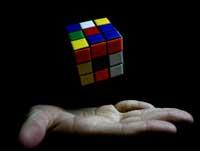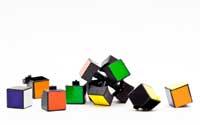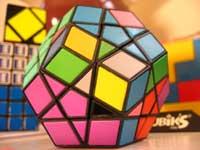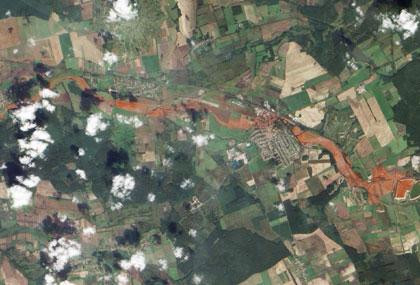Jira and return with the cubes of Rubik
2009/06/14 Lakar Iraizoz, Oihane - Elhuyar Zientzia

The best known cube is that of 9 cubes per face, but there are also more or less numerous cubes and other forms. The goal is to get a single color on each side of the cube. Why is it so difficult? So in the case of a bucket with nine buckets on each side, because there are 26 mobile buckets in total and the number of combinations they generate is huge. In total, more than 43 trillion movements can be performed; yes, a number with another 18 figures behind the number 43.
This mechanical plastic puzzle was first exported from his homeland in the 1980s, from Hungary. It was invented by the sculptor Ernö Rubik in 1974, three years later it was put on sale in Hungary and, after the success obtained, decided to open itself to the international scene. It is believed to be the world's best-selling toy: It is estimated that more than 350 million units have been sold.

A bucket of Rubik undone, you can see that the central buckets are always united, they can not be moved in any way. (Photo: Patricio Cuscito)
Insanity, Skill
To solve the cube of Rubik it is not necessary to depend on luck or tricks, there are many methods that must be followed step by step and that allow to obtain without problems that the colorful cubes that are tangled in the cube are brought to your group of colors.
There are manuals to teach how to solve the cubes. The first was published in 1981 and its author was a 12-year-old boy. Today, with the help of the Internet, you can find a multitude of instructions. Some show the steps to solve the bucket face to face, other steps to solve the bucket by strata, others prefer to solve first the bucket 2x2x2 and gradually extend until the whole bucket is resolved...
In the methods they give for beginners, that is, in the basics, about 100 movements are needed to form the cube. There are methods that use much less movement. However, to correct in its resolution, a minimum ability is necessary.

The bucket with 9 cubes on each side is the best known, but there are also more cubes and other shapes (Photo: Collin Anderson)
Mathematicians use computers to find the method that less movements would require lately. They have already found a mathematical method that resolves in a maximum of 22 movements. There is some competitiveness, which is the method of resolution of the minimum movement.
However, contests on Rubik cubes are not limited to this aspect. Regardless of the number of movements, since 1982 contests have been organized to solve the Rubik cube in the shortest possible time. The winner of the first contest took 22.95 seconds to solve it. As in all competitions, with the passage of time the previous brands have been improving and the smallest brand is already in 7.08 seconds.
The variants that have invented in terms of competition to solve the buckets are very funny. Among the most disparate competitions they have organized are contests to solve with closed eyes, to solve with one hand, to breathe and take the head under water, to solve with the fingers of the leg without ever leaving the head, etc. What a hobby!
Published in 7K.

Gai honi buruzko eduki gehiago
Elhuyarrek garatutako teknologia




